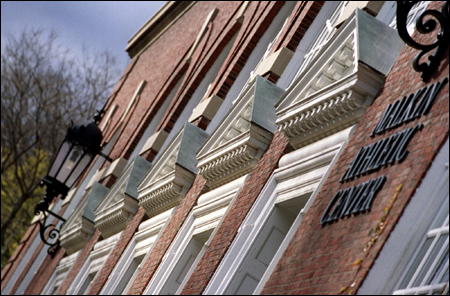MAC renovations to begin in June
Plans detailed for facility improvements and additional fitness equipment

The Harvard Department of Athletics has announced plans to expand and improve fitness facilities at the Malkin Athletic Center (MAC). The improvements will significantly increase the space available for both exercise and weight training.
“The physical well-being of our students, and indeed, of all members of the FAS community, is intertwined with their success in the classroom, at work, or in other areas of their overall development,” said William C. Kirby, dean of the Faculty of Arts and Sciences (FAS). “I am pleased that we can offer these enhanced facilities at the MAC.”
The MAC renovations are part of an ongoing effort to improve and expand athletic and recreational facilities on campus. In November, President Lawrence H. Summers and Harvard College Dean Benedict H. Gross provided each residential House with a $20,000 grant to improve or create its own fitness and recreational facilities. New fitness equipment was also recently installed at the Quadrangle Recreational Athletics Center (QRAC).
“It has been a steady effort to ensure that our students’ exercise needs are met,” said Gross. “Our students work intensely and work out intensely. They deserve the best support that we can provide.”
Plans for renovation will allow a significant increase in equipment that should help to alleviate crowding at the facility. The Athletics Department has set a goal of creating 35 new cardiovascular stations and 20 new weight-training stations, additions that would boost the amount of available workout equipment by nearly 90 percent.
The renovations to the MAC will expand the two weight-training areas on the ground floor by reconfiguring the walls that separate the equipment from the locker rooms. Above the pool, the currently underutilized north mezzanine will be enclosed to provide additional areas for cardiovascular equipment. The Athletics Department will also investigate the feasibility of creating more areas to house equipment on the gymnasium level.
All of these spaces will receive new equipment, fresh paint, improved lighting, air-conditioning, and flooring. The current mezzanine multipurpose room will also receive air-conditioning, while the existing cardiovascular fitness room will receive new flooring.
“The plans described will nearly double the space currently available for cardiovascular equipment, weight training, and exercise classes,” said Director of Athletics Robert L. Scalise. “We are excited to renovate the Malkin Athletic Center in a manner that will provide significantly more exercise and fitness opportunities to Harvard students and the University community.”
Renovations are expected to begin in mid-June and conclude by the time students return for the 2004-05 fall semester. During the renovations, the MAC will remain open and maintain its regular schedule. The Department of Athletics plans to keep the pool and locker rooms accessible during the renovation. A temporary relocation of weight-training equipment within the building during the summer will ensure continued access to those facilities.
The Athletics Department decided on the current path of renovations in an effort to address the most pressing concerns voiced by students and building users over the past two years. While the department continues to discuss additional improvements to athletic facilities, renovations of the building will offer immediate benefits to those who use its equipment.
“Users of the MAC consistently said their top priorities are increases in cardiovascular fitness space and weight-training facilities,” said Scalise. “This is the first step in taking care of a marvelous facility in a great location.”
The Malkin Athletic Center, then known as the Indoor Athletic Building, was constructed in 1930. Harvard has since modernized the facility several times, most notably with major renovations encouraged and supported by Peter L. Malkin ’55 and Isabel Malkin in 1985.




